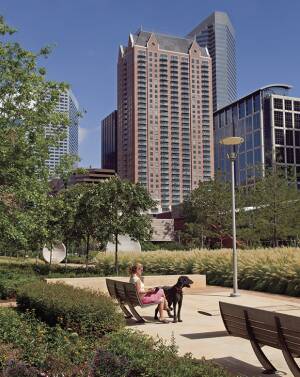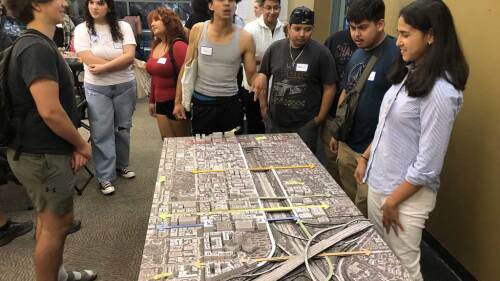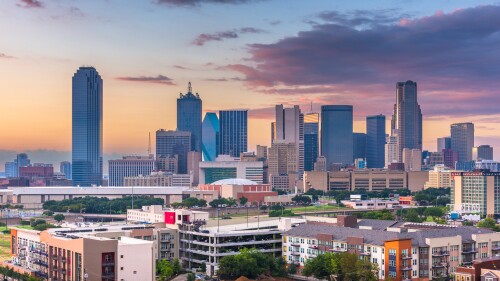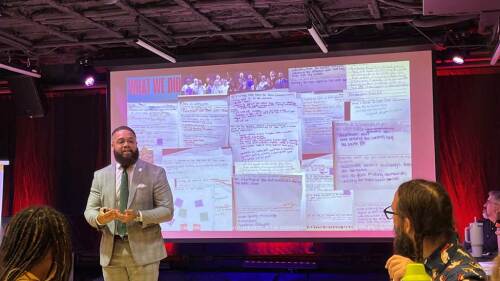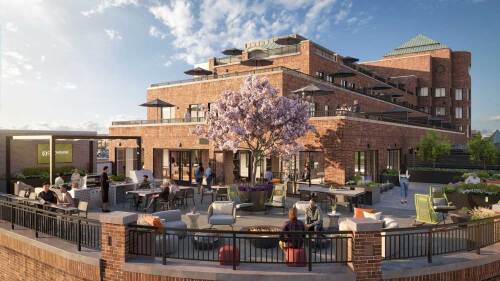The most expensive apartments per square foot in Houston are in a tower overlooking a park in a residential neighborhood now blossoming downtown. That tower, One Park Place, proved that luxury rental housing can thrive in a central business district still dominated by high-rise office properties.
“There had not been residential development downtown for decades,” says Marvy Finger, president and chief executive officer of the Finger Companies, developer of One Park Place, a 37-story tower that opened in 2010 with 346 luxury apartments.
Developers are now planning more than a dozen new apartment buildings downtown, drawn by the success of One Park Place—and a cash incentive program created by city officials. Officials and developers are trying to create a bustling downtown that not only has office towers, but also enough restaurants, residences, parks, and shopping facilities to attract new residents and new businesses for years to come.
Tour: Something Big Is Up Downtown| ULI Houston
Downtown Lures Developers
Developers are now planning $4.2 billion in new projects in downtown Houston—$2.2 billion of which are under construction, according to the Houston Downtown Management District (the Downtown District), an entity created by the state legislature in 1995 to guide investment. The new projects include 17 new multifamily developments, mainly rental apartments, thanks largely to Houston’s Downtown Living Initiative program. “We are trying to get to a critical mass of residential downtown,” says Annise Parker, Houston mayor since 2010.
Houston began its downtown initiative in August 2012, offering incentives for the construction of 2,500 units of multifamily housing downtown, including tax reimbursements of up to $15,000 per residential unit to development projects meeting standards set by the program.
Developers quickly claimed the tax credits, and Houston doubled the size of the initiative to a total of 5,000 housing units in 2014. Developers signed up for the last of these incentives early this year; however, some might drop out because of concern that Houston’s energy economy will be damaged by falling oil prices or that too much competition exists from other apartments under construction. “One or two may have stalled because of the change in the price of oil,” says Parker, but she notes that the city has a waiting list of other developments interested in the incentives.
Green Spaces, New Residents
For decades, downtown Houston has been a district of office towers. “The streets felt like concrete canyons,” says Ric Campo, chairman of Houston First, a local government corporation that operates convention and performing arts venues in the city. “There were parking garages and homeless people and no trees.”
Hot summers made the treeless streets and sidewalks difficult to bear, driving many office workers to spend their lunch breaks in downtown’s tunnel system, a kind of underground shopping mall connecting office buildings. After 5 p.m., those workers typically left downtown for homes in the suburbs.
But new residents are beginning to fill downtown sidewalks at all hours. The number of people living downtown will triple over the next few years, from just 3,600 residents now to more than 10,000, according to projections from the Downtown District.
Officials from organizations like the Downtown District are helping bring attractive residential development downtown with incentive programs like the Downtown Living Initiative and careful attention to the kind of amenities needed to create a mixed-use neighborhood, from retail space to well-maintained sidewalks. “You are beginning to put all of the pieces of the puzzle together—and it’s a very complex puzzle,” says Bob Eury, executive director of the Downtown District. Putting these pieces together required developers and city officials to work carefully together to leverage Houston’s resources.
“The big, heroic gestures are there, with the soaring skyline and the convention center, the basketball arena, soccer and baseball stadiums,” says Ann Taylor, executive director of ULI Houston. “These need to be stitched together with vibrant, pedestrian-friendly streets and public spaces.”
A Park Creates a Neighborhood
Discovery Green is one of those public spaces that stitches together a neighborhood. The 12-acre (5 ha) park opened in 2008 on what had been an ocean of parking spaces in front of the 1.9 million-square-foot (177,000 sq m) George R. Brown Convention Center. “Discovery Green has been wildly popular,” says Taylor. The park has more than a million visitors and is the site of more than 600 free events every year.
The new park immediately attracted residential development. Finger Companies finished its luxury apartments at One Park Place on the park in 2010, just two years after the park opened. “The park really started the cycle,” says Finger.
Back then, One Park Place was almost the only rental apartment community downtown, and certainly the only new one. Its leasing office opened in 2009, and the project endured the tough economic times triggered by the global financial crisis. Apartments rented slowly even after the developers offered prospective renters several months of free rent. “It was difficult to find anyone to walk through the building to give free rent to,” says Finger.
Now, the 37-story high rise is 98 percent occupied, and rents have risen by 8 percent a year for several years in a row.
“It is the place to live downtown right now,” says Campo, who is also chief executive officer of competing apartment developer Camden Property Trust.
One Park Place includes a 28,000-square-foot (2,600 sq m) retail space on the first floor, which is occupied by popular grocer Phoenicia Specialty Foods. “It’s a magnet for people from all over the city,” says Parker.
Discovery Green has also helped draw hotel development, which may attract more visitors to the convention center and customers to support the neighborhood’s retail spaces. “Houston is becoming a 24/7 city,” says Campo.
Workers are now putting the finishing touches on 1,000 new hotel rooms at a new Marriott Marquis hotel, which, like the 1,200-room Hilton America, overlooks Discovery Green. Shops and restaurants downtown will benefit from more visitors to the massive convention center, which will be able to schedule more events once the neighborhood has more hotel rooms. The new hotels will give downtown a total of 8,000 rooms, more than four times the 1,800-room inventory of 15 years ago.
Influencing Development
Developers who sign up for the Downtown Living Initiative Program have to follow the program’s exacting guidelines, which demand elements like large windows, wide sidewalks, and retail space when possible. “We are giving a serious financial incentive,” notes Eury. “You have to conform to the design standards to get the money.”
The guidelines rule out the kind of apartment buildings favored by many Houston developers, which consist of four floors of rental apartments over two floors of parking. Such buildings do not fit into the city’s plan to bring more retail space downtown; they cannot even be modified later to include retail space because the parking structure on the first floor is typically built of concrete.
Now that the incentive program funds are used up, the city has no carrots left to encourage developers to build the type of projects it prefers. However, the properties now planned are likely to have a defining effect on the downtown rental market. “Because of the number of projects, the initiative has given us the ability to change the feel of downtown dramatically,” says Eury.
For now, Houston is not planning to expand the incentive program again. “Let’s see how the projects stabilize,” says Parker.
Apartment Overbuilding
Those projects are likely to face some challenges, partly because the falling price of oil is hurting the energy business that has fueled Houston’s strong economy in recent years.
However, the city’s overall economy is still fairly strong. The city has added more than 100,000 jobs a year in recent years, a 4 percent increase. Houston will create far fewer new jobs in 2016—just 60,000, according to the latest forecast from the Greater Houston Partnership—but that still constitutes growth. And experts expected Houston’s growth to slow even before the global price of oil dropped. “A pace of 100,000 new jobs a year is not a sustainable pace,” says Sara R. Rutledge, director of research and analysis for CBRE Research. “We were expecting moderation.”
An oversupply of new apartments will be a larger challenge for the apartment industry in Houston. “We are well overbuilt,” says Finger. “There is free rent being offered all over the city. . . . It’ll take at least another two to three years to burn off all the excess supply.”
“Development can happen quickly and rather easily in Houston,” notes Eury.
During the earlier years of the economic recovery, when the metropolitan area had some of the strongest job growth in the country, developers started a large number of apartment properties.
They are scheduled to finish roughly 18,500 new rental apartments in 2015, and an average of about 1,000 annually over the next three years, according to a count by real estate data firm Reis—significantly more than the market will be able to absorb.
The apartment vacancy rate is projected to rise to 6.8 percent by the end of this year, up from 5.7 percent at the end of 2014, according to Reis. “Vacancy is forecast to be in the 8 percent to 8.5 percent range in four to five years,” says Brad Doremus, senior analyst for research and economics for the firm.
The submarket that includes downtown will be hit even harder, with a vacancy rate close to 15 percent over the next four to five years as the new units created by the city’s incentive programs are leased, says Doremus.
However, for the Finger Companies the benefits of the incentive program far outweigh the problems of oversupply, even though neither of its downtown apartment projects will receive any money from the program, says Marvy Finger. That includes One Park Place, as well as 500 Crawford Street, which will open hundreds of new apartments downtown this summer. Finger Companies announced the 500 Crawford development just before the city launched the incentive program.
For the Finger Companies, the real benefit of the incentive program is that downtown will have that critical mass of residents to support significant retail space. Downtown Houston lost a major retail amenity when its Macy’s department store closed in 2013 after losing its lease. An office tower is now under construction on the site.
However, Houston officials continue to use their influence, employing techniques such as land swaps, easements, and sidewalk improvement grants to encourage developers to add street-level retail space wherever possible. For example, near Discovery Green, the existing Hilton hotel is opening a new coffee shop. “They are building the largest Starbucks in Texas,” notes Campo.
The city is also planning new infrastructure, including new bus routes. Houston’s METRORail system will also expand with two new light-rail lines, now under construction, that will connect with the existing North Line at a new station downtown. The investment in transit will help make downtown Houston a place where residents can work, run errands, and get home without adding more cars to the already congested roadways. “Downtown is an environment that you can live in and not use a car,” says Eury.
Bendix Anderson writes about commercial real estate, sustainable development, and affordable housing.

